
Starting June 1st, 2023 Our warehouse fee will be $0.65/cubic foot per month
In effort to lower the warehouse storage fee during inflation, we have went narrow aisle racking.This construction took us four months but the project is finally completed. With narrow aisle racking, we are able to drop storage by 24%.We as partners will go through this inflation together.
08/08/2024
China, a country known for its rapid economic growth and global trade dominance, boasts some of the busiest and most advanced ports in the world. These major ports serve as gateways between the East and the West, handling huge volumes of cargo each year that fuel international trade. Its strategic location, modern infrastructure, and efficient logistics systems have made the Port of Shanghai a key hub in the global supply chain, reflecting China’s strength in maritime trade and global economic development.
China’s major seaports continue to lead the global maritime industry in 2025, despite increasing external pressures and global trade volatility. As the backbone of China’s export-driven economy, these ports are adapting rapidly to evolving geopolitical and economic dynamics.
Port of Shanghai remains the busiest container port in the world, surpassing 49 million TEUs.
Ningbo-Zhoushan Port followed closely with 35+ million TEUs.
Shenzhen, Guangzhou, and Qingdao consistently handled 20–27 million TEUs, reaffirming their importance in global trade flows.
🚩 Location: Located at the Yangtze River Delta, east coast of China. 🇨🇳
✔️ Annual Revenue: Approximately $30 billion USD.
✔️ Container Volume Handled: Over 49 million TEUs in 2024. Total cargo throughput to reach 1.12 billion tons in 2024. (Retained its position as the world's busiest container port for the 15th consecutive year.)
✔️ Container Handling Services: Offers comprehensive services including container loading/unloading, storage, and customs clearance.
✔️ Main Routes: Europe, North America, Asia.
✔️ Contact Information:
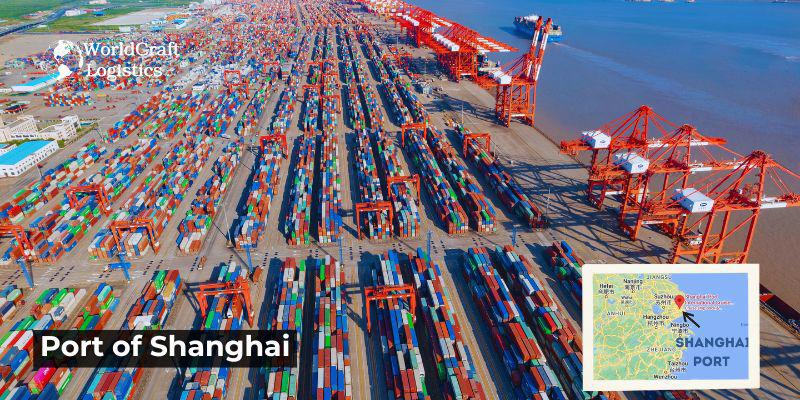
The Port of Shanghai, also known by its code CN SGH, is operated by the Shanghai International Port Group (SIGP). Since its inception in 1842, it has evolved into the largest and one of the most significant seaports globally, covering nearly 4 square kilometers. This port serves as a crucial transport hub due to its strategic location, connecting the Yangtze River to multiple Chinese provinces and offering extensive access to both Chinese seas and international oceans.
Handling over one-fourth of China's cargo traffic, the Port of Shanghai facilitates the import and export of key commodities such as coal, metal ore, petroleum and its derivatives, steel, and machinery. With 99 percent of Shanghai's foreign trade passing through, it stands as a vital gateway for China's international commerce. Often likened to a small city bustling with containers instead of houses, the port underscores its central role in global trade logistics.
As the world's leading port, Shanghai is a hub of international trade, driving economic growth and development in the region.
🚩 Location: Located in Zhejiang province, southeast coast of China. 🇨🇳
✔️ Annual Revenue: Approximately $25 billion USD.
✔️ Container Volume Handled: About 39.3 million TEUs in 2024.
✔️Total cargo volume: 1.37 billion tons, up 11% year-on-year and still leading the world in cargo throughput for the 16th consecutive year.
✔️ Container Handling Services: Provides services including container terminal operations, bulk cargo handling, and logistics solutions.
✔️ Main Routes: Southeast Asia, Middle East, Africa.
✔️ Contact Information:
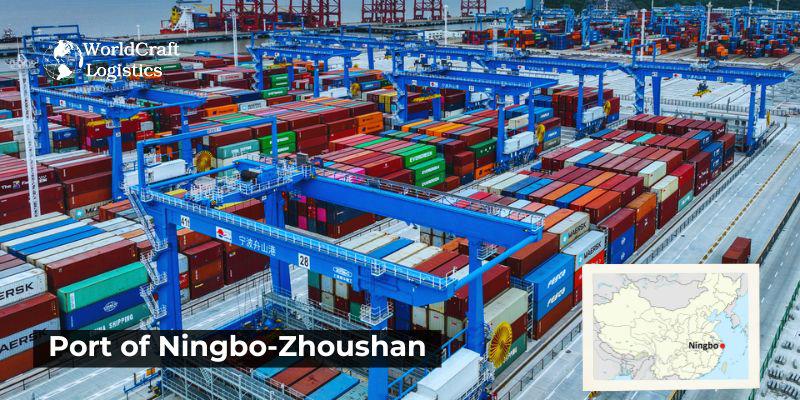
Ningbo-Zhoushan Port, renowned for its deep-water capacity essential for bulk and container shipping, is the world's busiest port in terms of cargo tonnage. In 2015, it handled an impressive ~890 million tonnes of cargo. Located in Zhejiang Province on the East China Sea coast, southeast of Hangzhou Bay and opposite Shanghai, the port is strategically positioned at the crossroads of north-south coastal and inland shipping routes, including the vital Yangtze River.
The port comprises several sections: Beilun (seaport), Zhenhai (estuary port), and Old Ningbo Port (inland river port). However, the water quality in Ningbo-Zhoushan Port has deteriorated significantly over the past decade due to extensive maritime traffic. The port is operated by Ningbo Zhoushan Port Co., Ltd. (NZP), a listed company with 76.31% ownership by the state-owned Ningbo Zhoushan Port Group as of June 30, 2017.
Ningbo-Zhoushan is a strategic port with extensive capabilities, supporting China's trade with key global markets.
🚩 Location: Located in Guangdong province. 🇨🇳
✔️ Annual Revenue: Approximately $3.5 billion.
✔️ Container Volume Handled: exceeded 30 million TEUs in 2024, up 13.7% year-on-year. Yantian Port, one of the main areas of Shenzhen Port, handled about 17.365 million TEUs, up nearly 7% from 2023.
✔️ Container Handling Services: Provides extensive container handling services with modern facilities and equipment.
✔️ Main Routes: Europe, North America, Asia.
✔️ Contact Information:
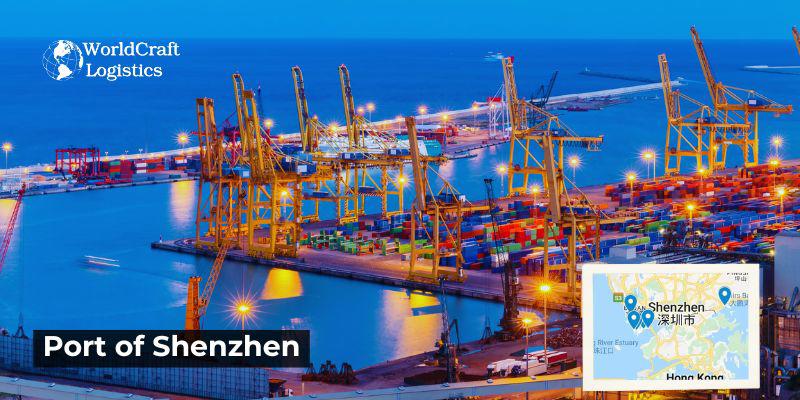
The Port of Shenzhen is a critical hub for international trade. This extensive port system, stretching along 260 km of coastline, is divided into eastern and western areas by the Kowloon Peninsula. The Port of Shenzhen encompasses several smaller ports along the Shenzhen coastline.
Home to around 40 shipping companies, the port has established about 130 international container lines and facilitates 230 international container routes. It connects to over 300 ports in more than 100 countries. Established in 1980, the port saw an investment of 60 billion yuan (approximately USD 9 billion).
By the end of 2010, it had developed over 170 berths, including 69 with a capacity of 100,000 tons and 44 designated for container ships. The port's annual transshipment capacity stands at approximately 194.9 million tons and 18.91 million TEUs. The Port of Shenzhen is crucial for global supply chains, linking the manufacturing hub of the Pearl River Delta to the world.
*The port is currently facing severe congestion ahead of the Lunar New Year holiday and the threat of tariffs from the US.
🚩 Location: Situated in Guangdong province. 🇨🇳
✔️ Annual Revenue: Approximately $3.2 billion.
✔️ Container Volume Handled: Around 23 million TEUs in 2024. In the Nansha port area alone, container throughput is expected to exceed 20 million TEUs by the end of 2024, marking an important milestone for this international shipping hub.
✔️ Container Handling Services: Full spectrum of container services, including storage, transshipment, and inland distribution.
✔️ Main Routes: Southeast Asia, Africa, Europe.
✔️ Contact Information:
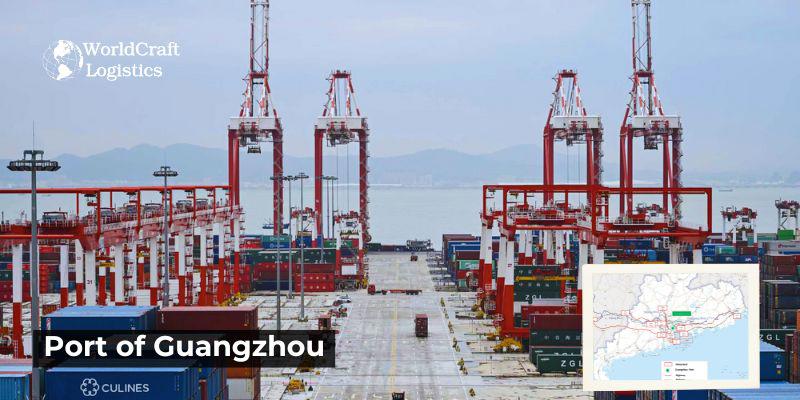
The Port of Guangzhou, the primary seaport of Guangzhou city, is operated by the state-owned Guangzhou Port Group Co. Ltd. Established on February 26, 2004, from the former Guangzhou Harbor Bureau, the company was approved by the Guangzhou Municipal Government. It is the largest comprehensive port in South China, connecting with over 300 ports in more than 80 countries and regions worldwide, and incorporates the former Huangpu Port.
As a critical economic and transport hub for the Pearl River Delta and Guangdong province, the Port of Guangzhou also supports industries in neighboring provinces such as Guangxi, Yunnan, Guizhou, Sichuan, Hunan, Hubei, and Jiangxi. The port boasts 4,600 berths, 133 buoys, and 2,359 anchorages, each with a 1,000-tons capacity, and the largest capacity reaching 3,000 tons. Approved dredging projects have enabled 100,000-tons vessels to enter the Nansha terminal at high tide since July 2009, with ongoing efforts to accommodate these vessels at low tide.
The Port of Guangzhou plays a crucial role in the economy, offering services such as loading and discharging, storage, bonded warehousing, and container cargo services. It handles a diverse range of products, including oil, coal, grain, chemical fertilizers, steel, ore, and automobiles.
🚩 Location: Located in Shandong province. 🇨🇳
✔️ Annual Revenue: Approximately $3 billion.
✔️ Container Volume Handled: Over 23.28 million TEUs in 2023. In May 2024, container throughput decreased by 7.3% compared to the same period last year.
✔️ Container Handling Services: Offers advanced container handling services with state-of-the-art equipment and efficient operations.
✔️ Main Routes: Northeast Asia, North America, Europe.
✔️ Contact Information:
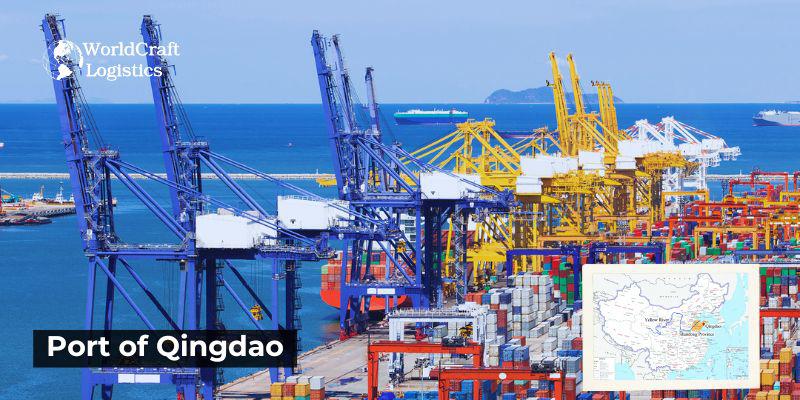
The Port of Qingdao, located on the Yellow Sea near Qingdao in Shandong Province, is one of the world's ten busiest ports, ranking 7th in total cargo volume in 2019. It encompasses the Qingdao Qianwan Container Terminal and the Qingdao Cosport International Container Terminal, among others, and features a significant terminal for handling iron ore.
Integral to the 21st Century Maritime Silk Road, the Port of Qingdao facilitates a trade route extending from the Chinese coast to Singapore, India, Mombasa, through the Suez Canal to the Mediterranean, and onward to the northern Italian hub of Trieste, connecting to Central Europe and the North Sea. Notably, since 2020, the port has been constructing the world's first suspended monorail capable of transporting fully loaded 20' and 40' containers, with the first phase operational in 2021.
Do you know which is the largest port in the world? Read this article to get the latest information 👉 Top 10+ largest sea ports in the US with billions of USD/year revenue
🚩 Location: Near Beijing, in Tianjin municipality. 🇨🇳
✔️ Annual Revenue: Approximately $2.8 billion.
✔️ Container Volume Handled: Around 27 million TEUs in 2024.
✔️ Container Handling Services: Comprehensive container services with advanced handling equipment and facilities.
✔️ Main Routes: North America, Europe, Southeast Asia.
✔️ Contact Information:
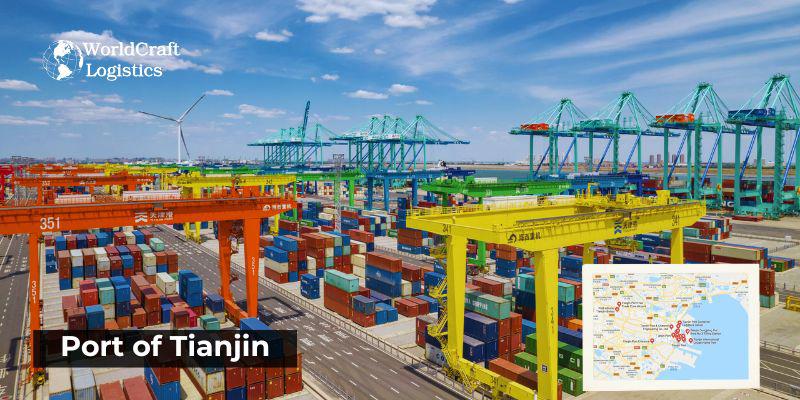
The Port of Tianjin, located on the western shore of the Bohai Bay in Tianjin Municipality, is the largest port in Northern China and a critical gateway for maritime trade.
The port encompasses a comprehensive array of facilities, including container terminals, bulk cargo terminals, and specialized terminals for handling hazardous materials and vehicles. It plays a vital role in international trade, connecting with over 500 ports in more than 180 countries.
The Port of Tianjin is strategically positioned along the 21st Century Maritime Silk Road, linking Asia with Europe and Africa through the Suez Canal. The port has undergone significant expansion and modernization to enhance its capacity and efficiency. This includes deep-water channels capable of accommodating the world's largest container ships and advanced logistics infrastructure to support seamless cargo handling and distribution.
In addition to its maritime significance, the Port of Tianjin is a pivotal economic hub, supporting industries in the surrounding Tianjin Economic-Technological Development Area (TEDA) and the broader Beijing-Tianjin-Hebei region. Its operations include a wide range of activities, from loading and unloading to storage and customs clearance, facilitating the export and import of various goods such as electronics, machinery, automobiles, and raw materials.
Tanggu Port is a significant part of Tianjin Port, one of the largest and busiest ports in the world. Located in the Binhai New Area of Tianjin, China, Tanggu Port plays a crucial role in facilitating international trade, particularly for northern China and the Bohai Economic Rim.
Key Information and Statistics about Tanggu Port:
Tianjin Port (which includes Tanggu) handles over 500 million tons of cargo annually, with more than 15 million TEUs (Twenty-Foot Equivalent Units) of containers each year. This makes it one of the largest ports in China by total cargo volume.
Tanggu is renowned for handling bulk commodities such as coal, steel, and automobiles. Additionally, the port deals with a substantial amount of containerized goods, including industrial and consumer products.
The Chinese government has heavily invested in Tanggu Port to expand and upgrade its infrastructure. This includes constructing new container terminals, enhancing automated operations systems, and improving connectivity with rail and road networks.
Tanggu Port is a strategic gateway for the import and export activities of northern China, particularly for major cities like Beijing and Tianjin. The port also plays a vital role in driving the economy of the Bohai Economic Rim.
The port boasts a highly developed transportation network, connecting with major rail and road routes. This allows for the efficient movement of goods from the port to various regions both domestically and internationally.
Tanggu Port significantly contributes to Tianjin’s GDP and is a key player in the global supply chain network, especially in sectors like industrial manufacturing and logistics.
In recent years, Tanggu Port has focused on minimizing its environmental impact by enhancing environmental protection measures and adopting green technologies in its operations.
Specific Statistics:
Container Handling Capacity: Over 15 million TEUs annually.
Total Cargo Volume: More than 500 million tons per year.
Channel Depth: Up to 19.5 meters, allowing the accommodation of some of the largest container ships in the world.
Port Area: Over 120 square kilometers of port area, with more than 200 active berths.
Vessel Turnaround Time: Typically takes only 8-12 hours from docking to completing cargo unloading and departure.
Tanggu Port is not only one of the largest ports in China but also a critical transportation hub on the global stage.
🚩 Location: Hong Kong Special Administrative Region. 🇨🇳
✔️ Annual Revenue: Approximately $4 billion.
✔️ Container Volume Handled: Around 13.69 million TEUs in 2024, down 5% from 2023
✔️Container Handling Services: Extensive services, including transshipment, warehousing, and value-added services.
✔️ Main Routes: Europe, North America, Southeast Asia.
✔️ Contact Information:
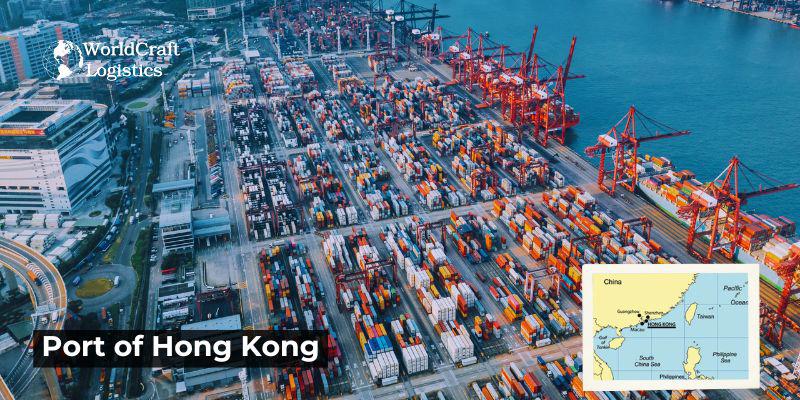
The Port of Hong Kong, located on the southern coast of China, is one of the world's busiest and most efficient ports. It serves as a vital hub for international maritime trade and is renowned for its deep natural harbor, which allows it to accommodate some of the largest container ships globally. The port operates round-the-clock and plays a crucial role in facilitating the flow of goods between Asia and the rest of the world.
The port consists of several key facilities, including the Kwai Tsing Container Terminals, which handle the majority of Hong Kong's container traffic. These terminals are equipped with state-of-the-art technology and infrastructure to ensure efficient cargo handling and swift turnaround times. Additionally, the port offers extensive warehousing, logistics, and distribution services, making it a comprehensive maritime logistics center.
Strategically located at the heart of Asia, the Port of Hong Kong connects to over 470 destinations worldwide, fostering strong trade links across continents. It is a significant component of the global supply chain, supporting industries such as electronics, textiles, and manufacturing. The port's free trade policies and efficient customs procedures further enhance its attractiveness as a key trade gateway.
Hong Kong's port also benefits from its integration with the Hong Kong-Zhuhai-Macau Bridge and extensive road and rail networks, ensuring seamless connectivity with Mainland China and beyond. This strategic position, combined with its world-class facilities, solidifies the Port of Hong Kong's status as a leading maritime hub in the region.
🚩 Location: Located in Fujian province. 🇨🇳
✔️ Annual Revenue: Approximately $2.2 billion.
✔️ Container Volume Handled: Over 10.36 million TEUs in 2024, up 1.8% year-on-year.
✔️ Container Handling Services: Comprehensive container handling, including automated systems and efficient logistics.
✔️ Main Routes: Southeast Asia, Europe, North America.
✔️ Contact Information:
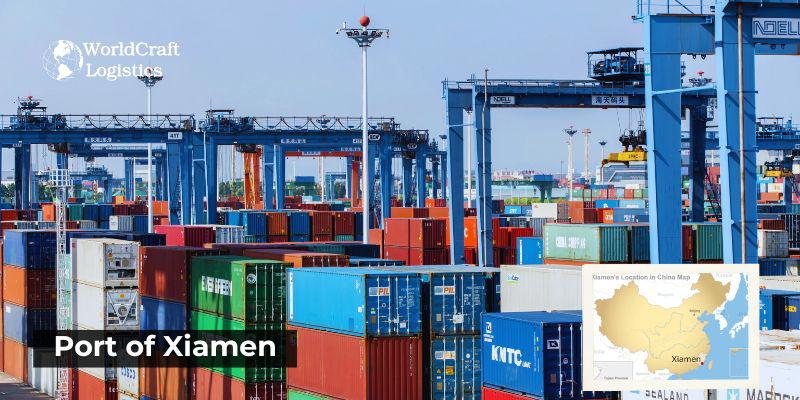
The Port of Xiamen, situated on the southeastern coast of China in Fujian Province, is one of the major deep-water ports in the country. Strategically located at the mouth of the Jiulong River, it faces the Taiwan Strait and serves as a key gateway for trade between Mainland China, Taiwan, and the broader Asia-Pacific region.
The port is renowned for its natural deep-water harbor, which allows it to accommodate large vessels, including some of the world’s largest container ships. The Port of Xiamen comprises several terminals, including container terminals, bulk cargo terminals, and specialized terminals for handling oil and gas. Key facilities include the Haicang Port Area, Dongdu Port Area, and the Songyu Port Area.
Xiamen's port infrastructure is modern and efficient, featuring advanced cargo handling equipment and extensive logistics services. It is well-connected by road and rail networks, enhancing its role as a regional logistics hub. The port has established trade routes with over 60 countries and regions, linking to more than 150 international ports.
In recent years, the Port of Xiamen has seen significant growth and development. It plays a vital role in the local economy, supporting various industries such as electronics, machinery, and petrochemicals. Additionally, it is a crucial part of the Maritime Silk Road initiative, enhancing its strategic importance in global trade.
The port's efficiency and strategic location make it a pivotal maritime hub in China, fostering robust economic ties and facilitating the seamless flow of goods across the Asia-Pacific region and beyond.
🚩 Location: Situated in Liaoning province. 🇨🇳
✔️ Annual Revenue: Approximately $1.8 billion.
✔️ Container Volume Handled: Around 5 million TEUs in 2024, up 13.1% year-on-year.
✔️ Container Handling Services: Offers extensive container handling services, with a focus on bulk commodities.
✔️ Main Routes: Northeast Asia, North America, Europe.
✔️ Contact Information:
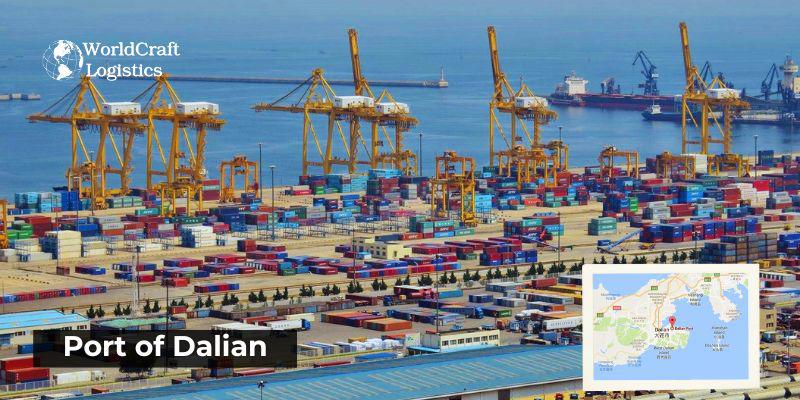
The Port of Dalian, located at the southern tip of the Liaodong Peninsula in Liaoning Province, is a key maritime gateway in Northeast China. As one of China's major ports, it serves as an important hub for international trade and shipping in the Bohai Sea region and beyond.
Established in the early 20th century, the Port of Dalian has grown to become a comprehensive port with a diverse range of facilities, including container terminals, bulk cargo terminals, and specialized terminals for handling oil, coal, grain, and automobiles. It boasts deep-water berths capable of accommodating the largest vessels, ensuring efficient handling of various cargo types.
Strategically positioned, the port facilitates trade between China, Japan, Korea, and Russia, and it is integral to the Belt and Road Initiative. The port's extensive connections with over 300 ports in more than 160 countries enhance its role in global trade networks.
The Port of Dalian is equipped with advanced infrastructure and technology, promoting high efficiency in cargo handling, storage, and logistics services. It is supported by robust transportation links, including road, rail, and pipeline networks, which integrate the port seamlessly with inland regions.
As a critical economic engine for the Liaoning Province and the greater Northeast China region, the Port of Dalian supports various industries such as petrochemicals, machinery, and textiles. Its strategic location and modern facilities make it a vital player in facilitating the import and export of goods, contributing significantly to regional and national economic development.
🚩 Location: Located in Liaoning province. 🇨🇳
✔️ Annual Revenue: Approximately $1.2 billion.
✔️ Container Volume Handled: Around 5 million TEUs in 2024, up 14.5% year-on-year.
✔️ Container Handling Services: Comprehensive services for container handling, including modern facilities and efficient operations.
✔️ Main Routes: Northeast Asia, Southeast Asia, Europe.
✔️ Contact Information:
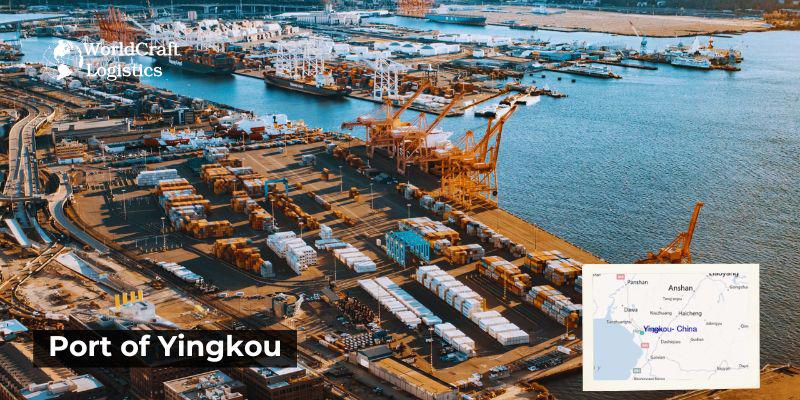
The Port of Yingkou, situated in Liaoning Province along the Bohai Sea coast, is a prominent maritime hub in Northeast China. As one of the oldest seaports in the region, it plays a crucial role in supporting the economic development and international trade activities of the Liaoning Province and the broader northeastern area of China.
The port has undergone significant modernization and expansion, boasting a range of facilities that include container terminals, bulk cargo terminals, and specialized terminals for handling commodities such as coal, grain, and chemicals. These modern facilities enable the port to handle a diverse array of cargo types efficiently.
Strategically located, the Port of Yingkou is well-connected to major domestic and international shipping routes. It serves as an important gateway for trade between China and other countries, particularly those in Northeast Asia. The port's extensive network connects with over 140 ports in more than 50 countries, enhancing its role in global trade.
The Port of Yingkou is supported by a robust transportation infrastructure, including road, rail, and inland waterway connections, which integrate the port with key industrial and economic centers in Northeast China. This connectivity ensures seamless logistics and distribution services, bolstering the port's efficiency and operational capacity.
In recent years, the Port of Yingkou has continued to expand its capabilities, focusing on improving cargo handling efficiency and environmental sustainability. The port's strategic location, modern infrastructure, and comprehensive services make it a vital node in China's maritime and trade networks, contributing significantly to regional and national economic growth.
🚩 Location: Situated in Jiangsu province. 🇨🇳
✔️ Annual Revenue: Approximately $1.1 billion.
✔️ Container Volume Handled: Around 5 million TEUs in 2024. Container throughput increased by 9.08% in the first quarter of 2025 compared to the same period last year.
✔️ Container Handling Services: Full range of container services, including storage, transshipment, and inland distribution.
✔️ Main Routes: East Asia, Southeast Asia, Europe.
✔️ Contact Information:
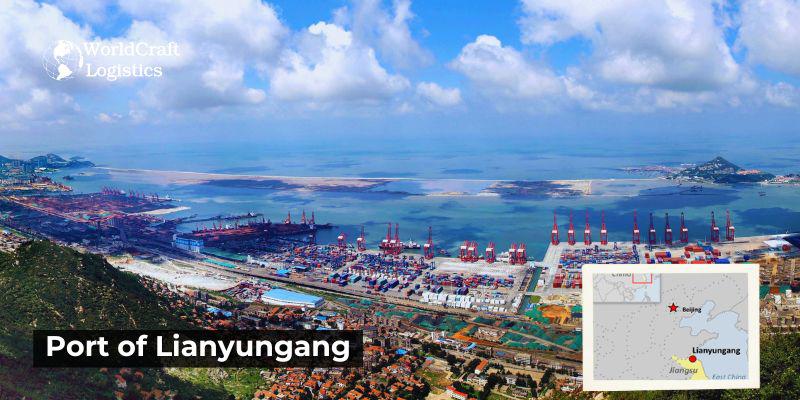
The Port of Lianyungang, located on the northern coast of Jiangsu Province along the Yellow Sea, is an important deep-water port in eastern China. It serves as a crucial maritime gateway for the Yangtze River Delta region and has been integral to the economic development of Jiangsu Province.
The port is equipped with modern facilities that support a wide range of cargo handling, including container terminals, bulk cargo terminals, and specialized terminals for handling commodities such as coal, oil, and grain. It is designed to accommodate large vessels, with deep-water berths that facilitate efficient loading and unloading operations.
Strategically positioned, the Port of Lianyungang connects to major international shipping routes and has established trade links with numerous countries and regions. Its location at the crossroads of the Yangtze River and the Yellow Sea enhances its role as a key hub for both domestic and international trade.
The port benefits from extensive transportation infrastructure, including well-developed road and rail networks that link it to inland areas and other economic centers in China. This connectivity supports efficient logistics and distribution, making the port a vital player in regional and national supply chains.
In addition to its role in international trade, the Port of Lianyungang is a key component of China's Belt and Road Initiative, further enhancing its strategic importance in global trade networks. Its modern facilities, strategic location, and comprehensive services position it as a significant maritime hub in eastern China.
🚩 Location: Located in Guangdong Province. 🇨🇳
✔️ Annual Revenue: Approximately $5 billion (2023).
✔️ Container Volume Handled: About 4.7 million TEUs in 2024. Cargo volume is expected to increase by 23% in the fourth quarter of 2024 to 16.6 million tonnes.
✔️ Container Handling Services: Offers container handling, bulk cargo operations, and logistics.
✔️ Main Routes: Key routes include Southeast Asia and domestic trade.
✔️ Contact Information:
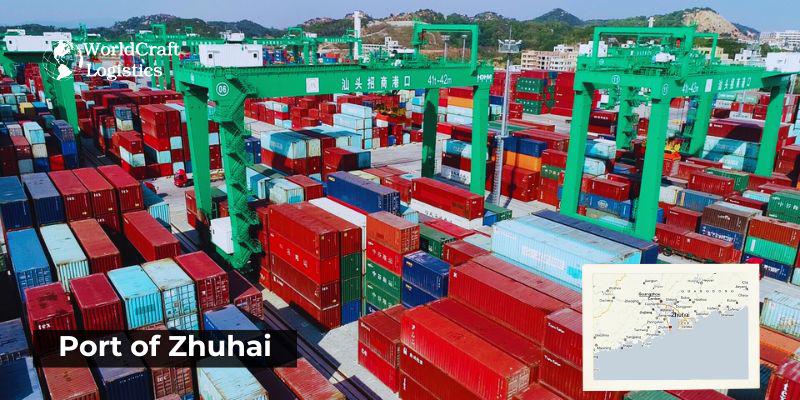
The Port of Zhuhai, located on the southern coast of Guangdong Province near the Pearl River Delta, is a significant maritime gateway in southern China. It serves as a crucial port for the city of Zhuhai and the surrounding region, providing vital connections for international and domestic trade.
The port comprises several key terminals, including container terminals, bulk cargo terminals, and facilities for handling specialized cargo such as oil and chemicals. Its deep-water berths are capable of accommodating large vessels, ensuring efficient cargo operations and facilitating trade with major global shipping routes.
Strategically situated near the Hong Kong-Macau-Zhuhai Bridge and the Pearl River Delta, the Port of Zhuhai benefits from excellent connectivity with both domestic and international markets. It is well-connected to major inland areas through an extensive network of roads and railways, enhancing its role in regional logistics and distribution.
The port plays an integral role in the economic development of Zhuhai and the broader Guangdong Province. It supports various industries, including electronics, textiles, and machinery, and contributes significantly to the region's trade activities. The Port of Zhuhai also serves as a key component of China's Belt and Road Initiative, linking China with global markets and enhancing its strategic importance in international trade.
Overall, the Port of Zhuhai's modern infrastructure, strategic location, and comprehensive services make it a vital maritime hub in southern China, supporting robust economic growth and facilitating efficient trade and logistics operations.
🚩 Location: Located in Fujian Province. 🇨🇳
✔️ Annual Revenue: Approximately $4.5 billion (2023).
✔️ Container Volume Handled: 1.48 million TEUs in 2024.
✔️ Container Handling Services: Provides container handling, bulk cargo services, and warehousing.
✔️ Main Routes: Major routes include Southeast Asia and domestic trade.
✔️ Contact Information:
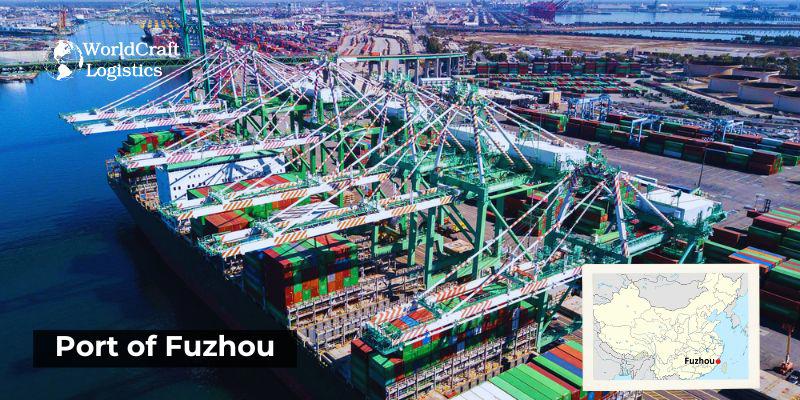
The Port of Fuzhou, situated in Fujian Province along the Taiwan Strait, is a key seaport in southeastern China. It serves as a major gateway for trade and transportation in the region, supporting the economic activities of Fuzhou city and the surrounding areas.
The port features a range of facilities, including container terminals, bulk cargo terminals, and specialized terminals for handling commodities such as coal, oil, and grain. Its deep-water berths are designed to accommodate large vessels, facilitating efficient cargo operations and enhancing its role in both domestic and international trade.
Strategically positioned, the Port of Fuzhou is well-connected to major shipping routes and has established trade links with numerous countries and regions. It plays a significant role in connecting China with global markets, particularly in the Asia-Pacific region.
The port benefits from strong transportation infrastructure, including road and rail connections that integrate it with key economic centers in Fujian Province and beyond. This connectivity supports efficient logistics and distribution, contributing to the port's importance in regional supply chains.
In recent years, the Port of Fuzhou has undergone modernization and expansion to enhance its capabilities and accommodate growing trade volumes. It is an essential component of the local and national economy, supporting various industries such as manufacturing, electronics, and textiles.
Overall, the Port of Fuzhou's modern facilities, strategic location, and robust transportation links position it as a vital maritime hub in southeastern China, playing a crucial role in facilitating trade and supporting regional economic development.
🚩 Location: Located in Guangdong Province. 🇨🇳
✔️ Annual Revenue: Approximately $4 billion (2023).
✔️ Container Volume Handled: Around 3.3 million TEUs in 2023.
✔️ Container Handling Services: Offers container handling, bulk cargo services, and logistics support.
✔️ Main Routes: Key routes include Southeast Asia and domestic trade.
✔️ Contact Information:
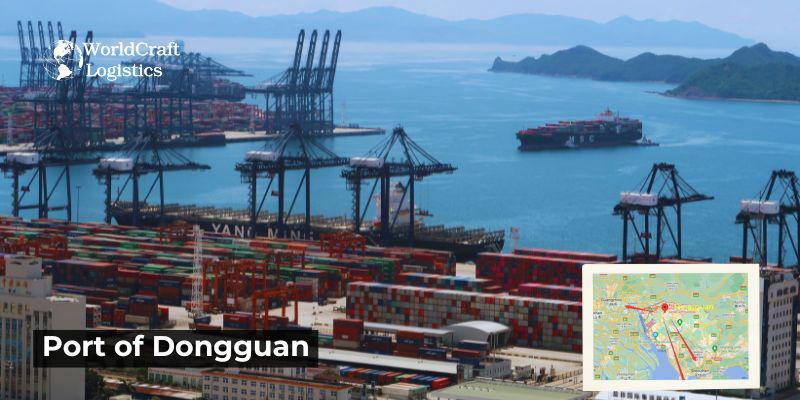
The Port of Dongguan, located in Guangdong Province, China, is an important maritime gateway situated along the Pearl River Delta. Serving the city of Dongguan and the surrounding region, it plays a vital role in facilitating trade and transportation in southern China.
The port features a variety of facilities, including container terminals and bulk cargo terminals. These facilities handle a diverse range of cargo, including manufactured goods, raw materials, and industrial products. Its strategic location within the Pearl River Delta enhances its connectivity to major domestic and international shipping routes.
Dongguan’s port benefits from a well-developed transportation infrastructure, including road and rail connections that link it to key economic centers within Guangdong Province and beyond. This connectivity supports efficient logistics and distribution, making it a crucial component of the region’s supply chain.
The Port of Dongguan supports the local economy by providing essential trade links for various industries, such as electronics, textiles, and machinery. It is a key player in the broader economic network of the Pearl River Delta, contributing to the region's robust trade and manufacturing sectors.
Overall, the Port of Dongguan’s facilities, strategic location, and transportation links make it a significant maritime hub in southern China, facilitating trade and supporting regional economic growth.
🚩 Location: Located in Guangdong Province. 🇨🇳
✔️ Annual Revenue: Approximately $3.5 billion (2023).
✔️ Container Volume Handled: About 3.5 million TEUs in 2023. (Specific figures for 2024 are not yet available)
✔️ Container Handling Services: Provides container handling, bulk cargo services, and logistics.
✔️ Main Routes: Major routes include Southeast Asia and domestic trade.
✔️ Contact Information:
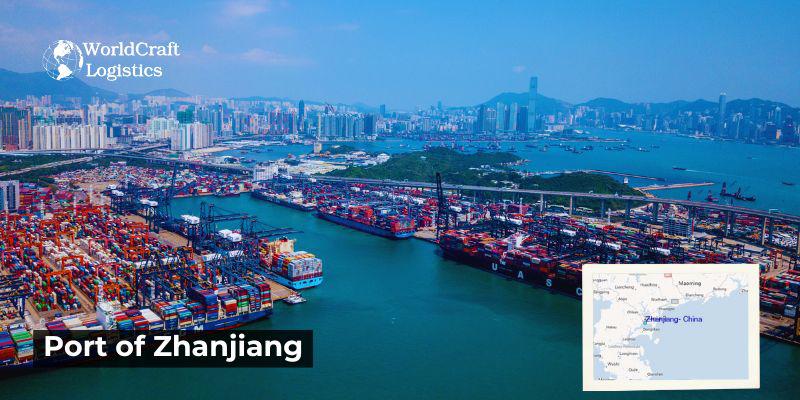
The Port of Zhanjiang, located in the southwestern part of Guangdong Province along the South China Sea, is a major deep-water seaport and a key gateway for international trade in southern China. Positioned strategically at the mouth of the Qiongzhou Strait, it provides vital maritime connections for the region.
The port features modern facilities, including container terminals, bulk cargo terminals, and specialized terminals for handling commodities such as coal, oil, and grain. Its deep-water berths can accommodate large vessels, which is crucial for efficient cargo operations and handling significant trade volumes.
Zhanjiang’s port benefits from its proximity to important shipping routes and its extensive transportation infrastructure, including well-developed road and rail networks. These connections integrate the port with key economic areas in Guangdong Province and the broader South China region, enhancing its role in logistics and distribution.
The Port of Zhanjiang plays a significant role in supporting the local economy, with a focus on industries such as petrochemicals, machinery, and textiles. It is also an integral part of the Belt and Road Initiative, contributing to China's broader trade and economic strategies.
In recent years, the port has seen ongoing modernization efforts to expand its capacity and improve its operational efficiency. Its strategic location, modern facilities, and comprehensive services make the Port of Zhanjiang a vital maritime hub, fostering regional economic development and facilitating international trade.
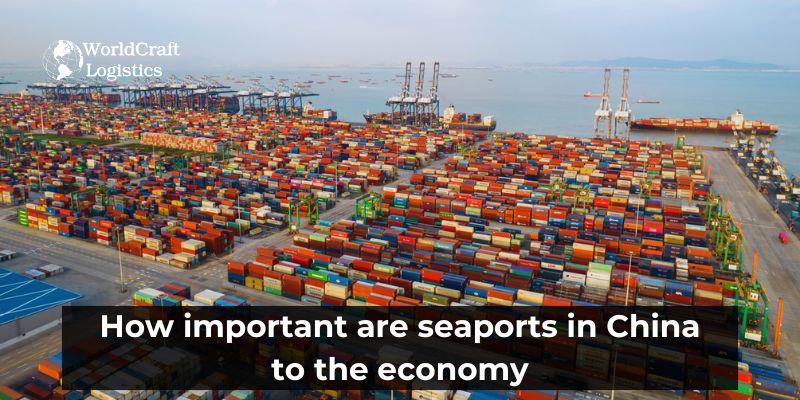
Seaports in China are crucial to the country's economy and play a significant role in its rapid economic growth and global trade dominance. Here’s an overview of their importance:
China is the world's largest exporter and second-largest importer, and its seaports are central to this status. Ports like Shanghai, Ningbo-Zhoushan, and Shenzhen rank among the busiest globally, handling immense volumes of containerized cargo that facilitate China's vast trade network.
A significant portion of China's GDP is driven by exports. Seaports are the gateways through which Chinese goods - ranging from electronics to textiles - reach international markets, making them vital to the country's economic structure.
Seaports are economic hubs that drive regional development. Cities like Shanghai, Tianjin, and Guangzhou have grown into major financial and industrial centers, largely due to the prosperity and connectivity offered by their ports.
Ports generate millions of jobs directly and indirectly. This includes employment in logistics, shipping, manufacturing, and service industries that support port activities.
China has invested heavily in port infrastructure, with initiatives like the Belt and Road Initiative (BRI) aimed at enhancing global trade routes. Modern, efficient ports are a key component of China's strategy to maintain and expand its trade routes.
Chinese seaports are at the forefront of adopting cutting-edge technologies, including automation, AI, and blockchain, to increase efficiency and reduce costs. This not only boosts the competitiveness of Chinese ports but also sets new standards for global maritime logistics.
Chinese ports are integral to global supply chains. They serve as critical nodes in the transportation of raw materials to manufacturing hubs and the distribution of finished goods worldwide. Disruptions in these ports can have ripple effects across global markets.
China is a major importer of raw materials, including oil, coal, and iron ore. Ports like Qingdao and Dalian are key in ensuring the steady flow of these resources, which are essential for China's industrial sectors.
The logistics and transportation sectors, heavily reliant on seaports, contribute a substantial portion to China's GDP. The efficiency and capacity of these ports directly influence the overall economic performance.
Beyond their economic roles, Chinese seaports have strategic military significance. They are key to China's naval power projection and are used to assert influence in regional and global geopolitics.
Chinese ports are central to the BRI, which aims to develop trade and investment links across Asia, Europe, and Africa. The initiative enhances China's global influence and creates new economic opportunities by expanding maritime trade routes.
Chinese seaports are more than just points of entry and exit for goods - they are vital to the economic, strategic, and geopolitical fabric of the country. Their development and efficiency are critical to sustaining China's economic growth and its position in the global marketplace.
In conclusion, the top 15 busiest major ports in China stand as pillars of the nation’s economic might and global trade influence. These ports, each a hub of activity and innovation, not only drive regional growth but also connect China with markets around the world. Their capacity to handle immense volumes of cargo, coupled with ongoing investments in technology and infrastructure, ensures that China remains at the forefront of international trade. As these ports continue to expand and modernize, they will play an even more pivotal role in shaping the future of global commerce, solidifying China's status as a dominant force in the maritime industry.
SEO
Digital Marketing/SEO Specialist
Simon Mang is an SEO and Digital Marketing expert at Wordcraft Logistics. With many years of experience in the field of digital marketing, he has shaped and built strategies to effectively promote Wordcraft Logistics' online presence. With a deep understanding of the logistics industry, I have shared more than 500 specialized articles on many different topics.

Hot News
08/05/2024
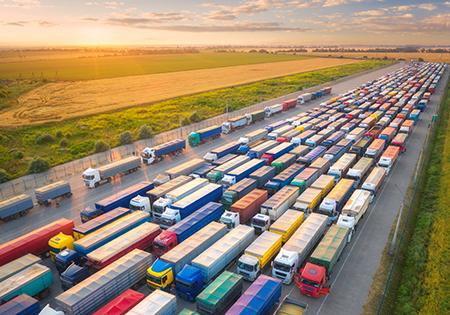
Hot News
02/23/2023

Hot News
02/23/2023

Hot News
02/06/2023
Hot News
02/07/2023